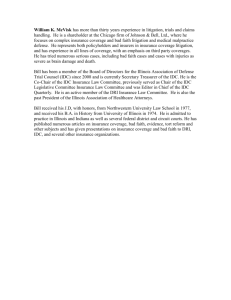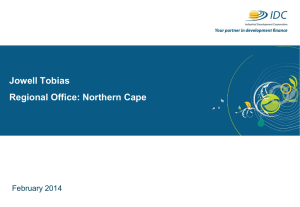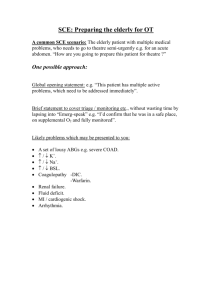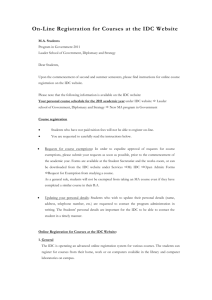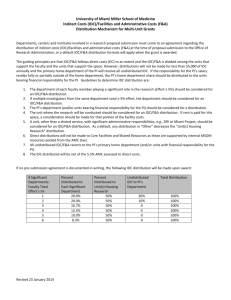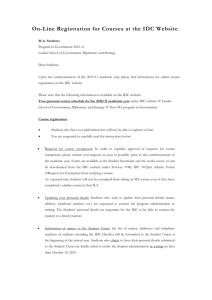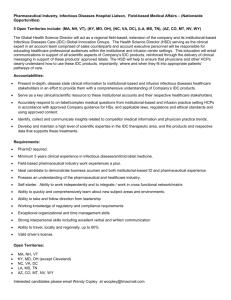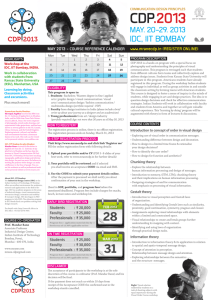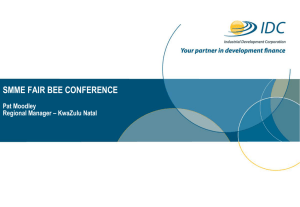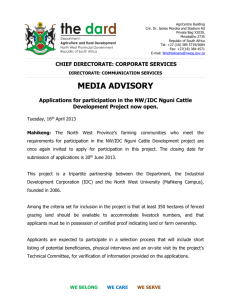IDC support for black industrialists
advertisement
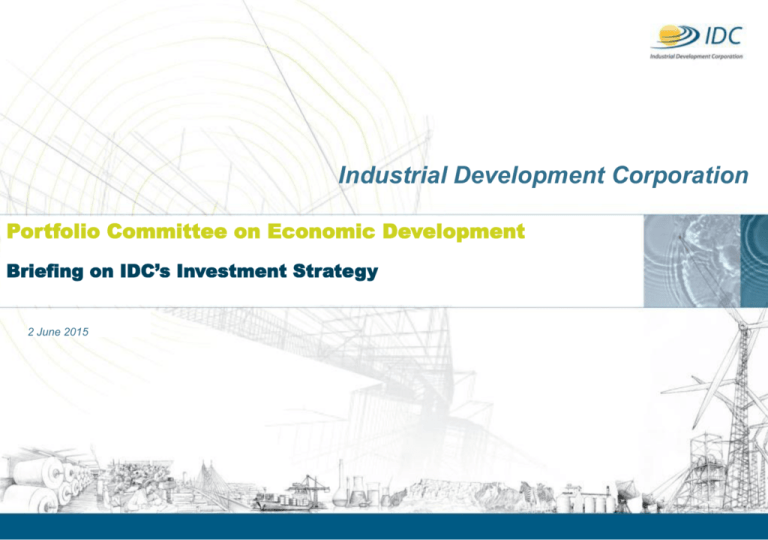
Industrial Development Corporation Portfolio Committee on Economic Development Briefing on IDC’s Investment Strategy Leading Industrial Capacity Development 2 June 2015 South Africa’s investment needs and challenges 2 SA fixed investment trends • Private sector fixed investment has been fairly modest in recent years, investment in the manufacturing sector almost unchanged over the period 2012 to 2014. • A substantial rise in fixed investment spending by public corporations since the early 2000s as Eskom and Transnet embarked on a massive drive to expand and improve the energy and transport infrastructure networks. • As some of the major projects near completion, the level of investment spending started to taper off in more recent years. • Investment spending by general government gained momentum through the roll-out of much need basic infrastructure. • The following factors are among those impacting on investment spending by the public sector: – More limited fiscal space due to substantial budget deficits and rising public sector debt; – Cost of funding on the rise; – Certain SOEs finding it difficult to raise sufficient capital for their investment plans. 3 Alignment of IDC’s investment approach to national strategies 4 Specific industry factors drive IDC planning for investment in certain industries at the micro level New Growth Path (Jobs drivers: Infrastructure, Agricultural value chain, Mining and beneficiation, Manufacturing sectors, Tourism and high-level services, Green economy, Knowledge economy, Social economy, African regional development) IDC sector development strategies (taking into account IDC’s Priority sectors identified in industrial policy ability to make a significant impact, constraints needing to be unblocked, opportunities in the industry etc.) Projects being developed by IDC Potential new industries for development not covered in industrial policy Expectations for levels of applications for funding from entrepreneurs Attractiveness of industry (job creation ability, other development outcomes risk, financial returns) Other considerations (economic conditions, typical size of businesses in industry, etc.) IDC Investment budgets per industry Potential to address development outcomes Primary: Facilitate sustainable direct and indirect employment Secondary: • Improving regional equity, including the development of South African rural areas, township economies, underdeveloped provinces and industrialisation in the rest of Africa; • Promoting entrepreneurial development and growing the SME sector • Transformational impact on communities and growing black industrialists • Environmentally sustainable growth • Growing sectoral diversity and increased localisation of production 5 2030 2029 2028 2027 2026 2025 2024 2023 2022 2021 2020 2019 2018 2017 2016 2015 2014 2013 2012 2011 2010 2009 2008 2007 IDC’s priorities are guided by relevant Government policies National Development Plan National Infrastructure Plan New Growth Path National Industrial Policy Framework/ Industrial Policy Action Plan + others such as B-BBEE, mineral development, tourism etc. Agricultural Policy Action Plan Industry involvement Industries covered by IDC investment as well as the development outcomes to be pursued in individual investments are guided by government priorities. Priority development outcomes 6 Funding activity over 20 years of democracy 16 14 • Saldanha Steel • Hulamin expansion 14 • Platmin 12 R billion 10 10 • Mozal 8 • Mozal II 8 6 6 4 4 2 2 0 -2 0 Value of IDC SA approvals (R billion in current prices) Value of IDC total approvals (R billion in current prices) SA real GDP growth (% change) Financial year -2 RDP National Policies Percentage 12 • Ohrongo Cement 16 • REIPPPP • Scaw NIPF & IPAP (revolving iterations) ASGISA GEAR NGP NIP NDP APAP IDC Strategies Strategy for Growth Leadership in Development Leadership in Industrial Development 7 4 2 0 Alignment of historical funding approvals with sector priorities Sectoral distribution of South African funding approvals Funding to the manufacturing sector (Avg. per year, 2014 prices) (2005 to 2014) 1414 Food and beverages R'bn R'bn 88 4 2 R488m Other services 1010 8 6 Clothing, textiles, leather and footwear 1212 R738m R241m Finance and business services R288m Transport, storage and communication R2 718m Wood products, pulp and paper Chemicals, rubber and plastics and nonmetallic minerals Basic metals Fabricated metals and machinery Trade and accommodation Transport equipment R781m 66 44 R1 124m R823m R266m R459m R2 491m Other manufacturing Construction R4 696m Electricity, gas and water supply -- R2 988m R404m 5% 10% 15% 20% % of funding to manufacturing 25% Manufacturing 22 R964m 0% Mining and quarrying Agriculture, forestry and fishing 2005 2005 to2005 2009 2009 toto2009 R529m 2010 2010 to2010 2014 2014 toto2014 • The revitalisation of the Industrial Policy Action Plan in 2010 and the introduction of the New Growth Path and National Development Plan in 2011 and 2013 saw increased direction in IDC funding to priority industrial sectors. 8 Key differences between IDC funding and that of commercial funders IDC Risk assessment • Based on expectations for the future of the business – i.e. business plan • Strong security not basis for support (in the absence of future viability, mandate fit etc.) Products and structuring • Repayment terms to suit the cash flow needs of the business. • Moratoria on capital and interest repayments during construction and early operations Pricing • Development impact taken into account along with cost of funding and risk when determining pricing • Subsidised schemes to achieve specific objectives Post-investment • Focusses on ensuring business sustainability in cases where the business experiences difficulty Stage of investment • Invests in early stage projects, rapidly expanding and developed/mature businesses including funding for distressed businesses Commercial funders Risk assessment • Based on historical performance of business • Strong security basis for support Products and structuring • Long-term funding generally not covered • Reduced equity instruments Pricing • Pricing based on risk and target returns Post-investment • Focussed on ensuring maximum recovery of funds where business experiences difficulty Stage of investment • Prefer to get involved at a later stage when risks have been identified and mitigated 9 Individual funding decisions IDC Act: “that every application or proposal dealt with by it is considered strictly on its economic merits, irrespective of all other considerations whatsoever” Development return (as measured through Development Scorecard) • Impact of funding through business entity • Can be outcomes (jobs, rural development, black economic empowerment, etc.), and / or • Development of new industries, strategic alignment, contribution towards industry development goals etc. • Where possible, IDC’s funding should be leveraged (syndication, other shareholder funds etc.) Financial return • Financial sustainability of business entity (measured through return on assets, return on equity) • To IDC: debt and equity priced as per pricing model (deviations to be justified/motivated to committee) • Generally in projects IDC would negotiate equity right. In existing businesses, equity could be proposed if the business is strategic for an industry that IDC wants to develop, if IDC plays a catalytic role, to warehouse shares for BEE or for IDC to share in the future returns. • Financial ratios – per broad sector; analysis across different ratios with mitigants where below norms • Own IDC equity generally have uncapped returns, with BEE funding returns mostly capped to improve vesting. • Decision based on future economic viability, not on strength of security Approach • Patient approach – Long-term tenures – Significant efforts made to restructure nonperforming clients where viability is evident in the future • Project development – Project expenses impaired until project completion/commissioning, then capitalised – Generally, IDC seeks a technical/marketing partner. 10 Challenges identified as part of Project Evolve • Our investment portfolio needs to be focussed on those areas which contribute to jobs rich industrialisation. • We need to integrate developmental outcomes e.g. jobs, black industrialists and community development into our funding operations. • We know that our human resource capacity is vital and we need to it competently to get the desired impact. • We need to optimise our processes and systems to be efficient and effective in our delivery. With this we needed to change focus and prioritise and also be clear on how we will implement this prioritisation. 11 IDC seeks to be at the centre of industrial capacity development Proactive industry developer Govt. Enabling activity Value Chains Producers Industry partners Relevant industry body Commercial banks and other financial institutions RoA To take greater leadership, forging strategic partnerships for developing the most important parts of the productive economy To decide how to actively engage with other sectors of the economy to drive outcomes 12 Activities are focused on sectors where we can achieve specific game changing impact • Support expansion/ modernisation of operations in existing SA industries & across Africa • Invest in growth sectors • Assist in the financing of new industries • Align with NDP, NGP and IPAP Promote expansion and extension of critical existing industries to increase jobs and drive economic growth Support attractive and high impact opportunities outside the Value chains Build industries that can become the basis for future jobs-rich industrialisation and economic growth Value chains High Impact New Industries High Impact allows IDC to fund high volume of opportunities with minimal effort, resulting in high impact return on effort New Industries are specific sub-sectors which are based on future trends and innovation, and could develop into significant opportunities for SA Value chains take advantage of economic linkages and achieve the biggest overall return on effort Value chains should be based on sectors that are large in terms of jobs and economic importance, to serve as drivers of both shortand long-term job creation & growth Industrial Infrastructure will be required to underpin the success of Value Chain New Industries activity 13 Investment budgets Historical Approvals and Capital Allocated Capital Allocation by SBU – 2014/15 to 2018/19 30 30 000 Historical actuals 25 Allocation - target Estimate 25 000 Allocation - base 20 000 R'm 20 R'bn Allocation - base Allocation - target 15 000 15 10 000 10 5 000 0 5 2006 2007 2008 2009 2010 2011 2012 2013 2014 2015 2016 2017 2018 2019 2020 • IDC annual approvals over the past five years was 57% higher than the previous five years. • Targeting to maintain and grow this to more than R100 billion over the next five years. • Various interventions will be adopted to increase IDC’s pipeline and increase development impact, using the following interventions: 14 Initiatives to increase industrialisation and development impact • IDC's development initiatives are captured here and include: • Increase localisation through infrastructure development • Retail off take opportunities • IDC support for black industrialists • Support for companies in distress • African regional integration • South African spatial development • Development of new industries 15 Initiative 1: Localisation of infrastructure partnering with State Owned Companies 16 State Owned Companies and localisation • In partnership with the PICC, the IDC has focused on three SOC’s (Prasa, Transnet and Eskom) which form the bulk of the current infrastructure spend of the state. We have engaged with them on the following areas: Current spend Analysis of current tenders and opportunities to support localisation and constantly engaging with SOC’s Future spend Working with and assessing the SOC’s spend cycle to determine opportunities for increasing local procurement Black Industrialist opportunities Analysing current and future spend to assist in the determination of entry points for Black Industrialists in SOC supply chain Future State Programmes Providing early stage input in state programmes to influence their localisation requirements (Coal RFP, Gas RFP and Nuclear programme). For projects that are supported by IDC within these programmes, IDC is setting higher thresholds for localisation and BEE 17 Eskom has Identified 42 priority focus areas for supplier development & localisation • The IDC is working with Eskom’s Supplier Development and Localisation (SD&L) and Group Commodity Sourcing Divisions to fast-track and promote localisation projects associated with Eskom’s capex and opex spending, as well as linking opportunities to Black Industrialists • A number of projects have been identified associated with generation (boiler and turbine systems), transmission and distribution (transformers) Component Project Description Boiler Tubes Local manufacture of seamless boiler tubes Transformers Local manufacture of medium to high voltage transformers Turbines Local manufacture of turbine blades Air Preheaters Support the tier 2 and tier 3 components industry particularly promoting the participation/formation of Black Industrialists • Maintenance spending at Eskom is expected to progressively increase over the next decade, as many of Eskom plant reaches end of life. • Eskom is concerned by increasing costs of maintenance spending on imported items, and is therefore looking at the establishment of a base of local industries to mitigate the exchange rate effect. 18 Transnet has identified 56 supplier development opportunities within its rolling stock capex plan • The IDC is working with Transnet’s Group Procurement to fast-track and promote rail and rolling stock localisation projects associated with Transnet’s capex and opex spending • Transnet has already issued the bulk of their rolling stock tenders to a number of companies. These companies have made localisation commitments as part of the tender conditions Component Project Description Train wheels 34” wheels Bearings Wheel bearings supply and refurbishment Axles Manufacturer of railway axles Bogies Manufacturer of bogies components Coupling Manufacturer of coupling systems • The Localisation Unit is working with these companies to identify the support needed to fulfil their localisation obligations • This includes identifying opportunities for Black Industrialists in the Transnet supply chain 19 REIPPPP Rounds 1 to 3: IDC participation in support of the development of a green industry 4% SOLAR PV IDC 10% 96% • 33 Projects, 1484 MW IDC WIND 90% Total Investment – R42bn CSP IDC Total bid windows 1- 3 Investment R117bn Total Investment – R41bn HYDRO IDC 22% 78% • 22 Projects, 1984 MW 30% 70% • 5 Projects, 400 MW • 2 Projects, 14 MW Total Investment – R34bn Total Investment R631m 20 IDC involvement in RE-related manufacturing • The following projects are at various stages of the project pipeline, from those being built to those completed and in production Client Name Technology Value (ZAR million) Jobs Capacity p.a. 144.5 191 120 MW ILB Helios South Africa (Pty) Ltd PV panels Greenbro (Pty) Ltd SWH geysers 4.3 24 n/a Amisec (Pty) LTD ta Art Solar PV panels 62.5 80 35 MW LED Lighting South Africa Energy eff. lighting 5.5 20 n/a Hybrid Geyser SWH geysers 8.2 27 1500 units ILB Power Systems PV inverters 20.0 37 60 MW Eveready Small wind towers 22.5 30 0.5 MW Solaire Direct Technologies PV panels 4.0 120 80 MW DCD Wind Towers Wind towers 14.1 203 110 units 21 Designated products offer an opportunity for localisation and Black Industrialists Recently announcements for new products being designated • Construction materials – Cement – Fabricated structural steel – Pipes and fittings – Roofing materials – Frames – Sanitary ware – Glass Current Designated and Implemented Products • Transformer components • Conveyance pipes • Renewable Energy manufacturers/assemblers are asking for government intervention to ensure higher uptake of locally produced components, possibly through designation. Future potential • RE components (solar and wind), power generation equipment (boiler tubes, turbine blades, air heaters, isolators, heat exchangers etc.), medical devices (syringes, scanners etc.), road studs, water and sanitation (waste water pumps). IDC is working with the dti on transformers, paint, flatboard, ceilings and partitioning, roof trusses and yellow metals. Yellow metals have been accepted for designation by thedti based on a report by the Localisation Unit. 22 Localisation SCAW Metals Summary • Scaw employs about 6 400 people, manufacturing grinding media, wire rod products, cast products, and rolled products. The company’s products are important inputs into the construction, mining, power generation, rail and other sectors. • IDC acquired Scaw from Anglo-American PLC in 2012 in pursuit of its strategy to intervene in the South African steel industry to ensure competitively priced steel supplies to downstream industries to increase localisation. • Scaw is well positioned to capture growth in the mining, railway and power generation sectors. It is the only producer of locomotive frames in Southern Africa and one of a few in the world. IDC is currently involved in a process to modernise the company. Location • Germiston, Gauteng with other parts of the group operating in Namibia, Zimbabwe, Zambia, Australia and Italy IDC investment • IDC’s exposure is R3.6 billion Job creation • No jobs were expected to be created immediately when IDC acquired Scaw. There was a concern that other bidders in the process would have dismantled the plant and moved it offshore. Ownership and BEE status • 21% of the company is held by Main Street 510, a BEE consortium. 5% of shares is held by an employee share ownership plan, with the remaining 74% held by IDC. Other impacts • Localisation of inputs to infrastructure development. Status • Mature company 23 Women empowerment, localisation Commuter Transport Engineering - CTE Summary • This company was established with a modest capital investment of R600 000 by Ms. Patricia Norris, a black woman and a loan facility of R1.5 million from IDC in 2000. • CTE has now grown into a formidable player in the Metrorail commuter coach rebuilding and refurbishment industry generating record annual turnover levels, and providing employment to more than 1 000 people. • With the IDC funding, the operations have expanded into KwaZulu-Natal and Gauteng. • This company was the first and remains the only black woman wholly owned company to successfully contract with Passenger Rail Agency of South Africa (PRASA) for the refurbishment of Metrorail coaches servicing the greater Cape Town Metropolitan. • The Gauteng operations acquired from Union Carriage and Wagon was involved in the assembling of the Gautrain coaches and manufacturing of over 1 000 electric/diesel locomotives for Transnet. Location • Touwsrivier, Western Cape • Pietermaritzburg, Kwa-Zulu Natal • Nigel, Gauteng IDC investment • Over the years the IDC has invested in various expansion programmes of the company totalling c.a. R350 million. Job creation • Collectively the CTE Group employs c.a. 900 people. Ownership and BEE status • This company was the first and still remains the only black woman wholly owned company to successfully tender and be awarded the coach refurbishment contract by PRASA. Other impacts • This investments facilitates increase localisation, job creation, black empowerment. 24 Initiative 2: Retail off-take opportunities 25 Retail off-take opportunities (1) The IDC has entered into preliminary discussions with various retailers for the local manufacturing of the following: • Solar Water Heaters in support of the government’s SWH rollout programme • The Government has a target of rolling out 1 million solar water heaters. • Solar water heaters are locally manufactured. • Eco timber and furniture including those manufactured from invasive alien vegetation • Whilst furniture is a growth area, there is a shortage of local manufacturers and designs and innovation are poor. But these limitations can be addressed. • The sector is labour intensive and would benefit from vertical integration. • There is a gap in the market for outdoor patio furniture and work stations etc. • There is a window that exists that makes local manufacture attractive - import duties, freight charges and unfavourable exchange rate for importers. • High demand for shutter ply used for foundations in the construction sector. • Consumer electronics such as smart phones and EDTVs • Significant opportunity exists for low cost smart phones. • Africa is a continent with very high mobile phone penetration rates. • Local manufacturers could potentially enter the cellphone market and would also be cost competitive. 26 Retail off-take opportunities (2) • Fast Food Retailers: • Potential to locally source furniture and interiors for food chains that have a presence outside of South Africa and want to retain an authentic South African look-and-feel in their stores globally. • A chain is planning to revamp all their stores with a new range of locally made furniture that showcases South African talent and culture. • The chain has already engaged designers of furniture and has prototypes ready. • Agro-Processing • Opportunities exist to integrate emerging farmers into the food retail value chain. • Emerging farmers would need assistance with packaging their plans to achieve bankability. • IDC would serve as a “go-between” between the emerging farmer and the large retailers to ensure alignment between the retailers’ needs and the farmers’ offering. 27 Initiative 3: IDC support for black industrialists 28 Barriers facing black industrialists The IDC has identified the following barriers which black industrialists are faced with when attempting to start or expand businesses: Access to capital • Own contribution can be prohibitive. • Lack of a track record and security hinders access to funding from banks. Access to markets • Black industrialists do not have long-standing relationships and networks in business that facilitate access to markets. Access to opportunities • Lack of experience, track records and reputation as well as access to information can restrict opportunities. Access to Information • Limited access to information in respect of available capital, opportunities and markets. Capacity and skills • New businesses have a high rate of failure, often due to a lack of management experience and skills despite the necessary technical skills. Continued monopolistic structures • The monopolistic nature of certain industry structures continues to exclude new entrants. 29 IDC B-BBEE Strategy Framework IDC is working towards the creation of an equitable society as envisaged by South Africa’s constitution by focusing on the role that it can play by implementing its mandate of industrial development and through internal transformation Internally focussed initiatives Strategies Focus areas Objectives Externally focussed initiatives Broaden transformation Broaden participation in of industry in all facets of economic benefits of B-BBEE industrial development B-BBEE Codes of Good Practice Inclusive wealth Growth of businesses with black ownership Increase participation of individuals in the country’s industrial development Ensure internal transformation Blackempowered businesses Black industrialists B-BBEE Codes of Good Practice • Driving broad-based • Funding communities to • Funding transformation at our take a stake in projects businesses business partners through (start-ups, expansions). with black the Codes of Good • Funding workers to take a shareholding Practice. stake in businesses (start(start-ups, • IDC as a B-BBEE ups, expansions). expansions). facilitator. • Increasing empowerment of black women, the youth and disabled. • Supporting black industrialists to build new • Manage all elements of capacity IDC’s own B-BBEE rating - Start-up level - Expansions - Management control • Expansionary acquisitions by black - Skills development industrialists - Enterprise and supplier • Supporting existing black industrialists to development grow their businesses through acquisitions - Socio-economic • Support potential black industrialists to development acquire businesses. 30 IDC’s definition of a black industrialist A black industrialist is defined as a black entrepreneur who creates and owns industrial capacity and provides long-term strategic and operational leadership to the business and is by definition not a portfolio or purely financial investor. The following are characteristics of a black industrialist: • Provides strategic and operational leadership to the business; • Has a high level of ownership (>50%) and/or exercises control over the business; • Identifies opportunities and develops business to take advantage of these opportunities (entrepreneurial); • Takes personal risk in the business; • Does business in manufacturing and in productive sectors identified in the NGP (jobs drivers), IPAP, APAP and IDC focus areas; • Makes a long-term commitment to the business and is not a short- to medium-term investor. While there would be a desire to develop black industrialists that own 100% of the business, it is accepted that this is not always possible since there may be a need to include other shareholders to attract relevant skills and finance. 31 IDC Strategies for black industrialists Assisting black industrialists with start-ups of new businesses and expansions of existing ones • Emphasis on business development and assistance Acquisitions of existing businesses by black industrialists • Ensuring >50% of funding stays within business for expansion and/ or; • Funding for strategic acquisitions >R 75 million Addressing issues related to access of capital • Low own contribution from black industrialist in exchange for tangible commitments and more use of direct equity instruments • Lowering cost of funding for black industrialists Addressing issues related to access to markets • Incubation strategies involving private partners or SOCs to support Black Industrialists Addressing issues related to access to capacity and skills • Strengthening of IDC’s business support programme for black industrialists 32 Targeted funding for black industrialists • IDC is targeting to channel 22% of its overall budgeted investment over the next five years to black industrialists; • This equates to R23 billion; • IDC has announced a special pricing regime for black industrialists: • 150 basis points reduction on normal IDC pricing for all black industrialists qualifying according to IDC’s definition; • Additional 160 basis points available for other priority development objectives. • IDC funding is available for all new entrants as well as established entrepreneurs to grow their businesses; • Funding will be available to all sectors that IDC covers 33 IDC’s performance in funding BEE IDC Funding for Black Empowered Companies 8 7 Between 25% and 50% black shareholding >50% black shareholding >25% black shareholding •IDC’s initial approach to BEE was to fund acquisitions of shares in existing companies by black shareholders. •Some transactions funded up to 2008 included acquisitions of shares included Metropolitan Life, MTN, Tourvest, Protea Hotels, 6 The Reclamation Group, Foodcorp, KWV, FirstRand Exxaro, and Life Healthcare •Value of IDC funding for black enterprises has been 4 increasing steadily over the past 20 years. 3 •The number of BEE transactions peaked in 2002, at close to 200 2 •Over the last 20 years the IDC has provided R28 billion to 1 black-owned businesses and funded over R53 billion to 1993 1994 1995 1996 1997 1998 1999 2000 2001 2002 2003 2004 2005 2006 2007 2008 2009 2010 2011 2012 2013 2014 2015 R'bn 5 black empowered in total. •Despite moving away from funding pure acquisitions, IDC maintained high levels of BEE funding. 34 Empowerment in energy sector Tshedza Mining Resources Summary • Tshedza Mining Resources (Pty) Ltd (Tshedza), has signed a 15-year coal supply and off-take agreement (CSA) with Eskom for its newly developed Manungu Colliery (Manungu), also known as Eloff Colliery, in Delmas, Mpumalanga. • The Colliery is contracted to supply 100% of its production to Eskom with an average of 1.62 million tonnes per annum (Mtpa) of coal for the first three years to Kendal Power Station, followed by an average of 3 Mtpa to Kusile Power Station (scheduled completion mid2018) for the remaining 12 years of the contract. • Tshedza will be one of the top four suppliers to Kusile Power Plant once it comes online, supplying between 15% and 20% of the total coal requirement. • IDC funding will be used for completion of the mine development, weighbridge and other infrastructure required to bring the mine to production and for working capital, which will help finance the mine’s operating costs for the three months preceding first coal production and sales. Location • Mpumalanga IDC investment • IDC approved – R210 million Job creation • The Company will initially employ 219 people ramping up to 403 on full production in 2018 Ownership and BEE status • Tshedza is 51% black owned and a Level 3 contributor to BBBEE. 35 Empowerment in underdeveloped province “Newco” (Pty) Ltd Summary • IDC initiated the project about three years ago, to produce packaging paper from waste paper. • The project has an experienced operating partner with 51% shareholder, operator and the major off-taker of product. Construction will commence in January 2016 and production is due to start during 2018. • The project has various green energy components such as: • Waste paper as an input material • Base load electricity will be generated on site via a backpressure turbine fitted onto a slightly bigger coal fired boiler • A semi-closed water loop, to ensure water consumption is kept to a minimum • An energy efficient fibre production process to utilise around 10% newspaper waste also for input material • The total development cost is around R1,8 billion. The shareholder/operator to introduce R250 million • China Export- and Import Bank to assist with funding of the process equipment (Paper Machine) which is imported from China. • Waste collection model to be integrated into the waste supply chain which will focus on “small-town” and rural area waste collection with the focus on employing rural woman and the unemployed. Location • Mafube, Free State IDC investment • IDC provided R732 million for this investment Job creation • Will create 2 658 jobs (including construction and waste collectors) Ownership and BEE status Black Industrialist IDC 51% 49% 36 Empowerment in rural area through mining Kalagadi Manganese Summary • The project entailed the establishment of a manganese mine, beneficiation plant and sinter complex in the Northern Cape. • The Kalagadi Manganese Project consists of the establishment of a 3 million tonnes per annum manganese ore mine and a 2.4 million tonnes per annum sinter plant (the world’s largest), at Hotazel in the Northern Cape. • A further 320 000 tonnes per annum ferromanganese alloy production facility may be constructed at Coega in the Eastern Cape in the future. • In 2009, the sinking of the mine shaft and the construction of surface infrastructure commenced. In the second half of 2010, the bulk earthworks for the sinter plant was completed and in the first half of 2011 the construction of the sinter plant began. • Total capital outlay of the project is R11.9 billion. R8.9 billion will be spent locally during the construction phase, followed by an estimated R7.6 billion during the first full year of production. • Although highly capital intensive in nature, the project will bring great benefit to the South African economy through its strong linkages with domestic suppliers of goods and services. • Kalagadi is set to not only generate increased economic activity throughout various sectors of the Northern Cape economy; it will also result in the development of critical infrastructure valued at about R460 million. Location • Hotazel, Northern Cape Job creation • 25 000 job opportunities (including construction jobs). Other impacts • Regional development • Export earnings • Women empowerment 37 Green Industry Development Nobomate Material Recycling Facility Summary • Nobomate is owned by New GX Enviro Solutions and Logistics Holdings (New GX). New GX was established in 2011 and has interests in waste management, recycling, environmental consulting and bulk logistics. • Nobomate provides waste management services to approx. 90 000 households in Regions 3 and 4 of the City of Tshwane (“CoT”), comprising of Atteridgeville, Lotus Gardens and Olievenhoutbosch. • These services include weekly removal of household waste, litter picking, prevention of illegal dumping and promotion of community based recycling initiatives. There are approx. 300 000 households in Regions 3 and 4. • CoT has an Integrated Development Plan (“IDP”) objective of reducing waste to landfills by 50% by 2016. In order to support the realisation of this objective, the City has to start implementing appropriate measures and has to this extent given Nobomate consent to establish a material recycling facility (MRF” at the Kwagga landfill buffer zone (as a first of four planned such facilities). • All recyclable waste from Regions 3 and 4 will be diverted to this MRF. Nobomate is a Management Contractor to the CoT and this business model enables simultaneous delivery of waste management services, job creation opportunities for local communities as well as development of SMMEs. • The project is consistent with the CoT’s Vision 2055 and the Green Economy Framework which aims to eliminate reliance on landfills by moving up the waste hierarchy. Location • Attridgeville, Gauteng (Johannesburg) IDC investment • IDC approved R22.1 million Ownership and BEE status • 100% Black-owned (Black Industrialist) 38 Empowerment in the tourism industry Tourvest Holdings Summary • Tourvest was established in 1997 through incorporation of a number of established tourism companies and was listed on the JSE. • It is Southern Africa’s number one tourism group, offering a range of products and services that encompass the needs of all visitors to Southern Africa. The group is made up of destination management, travel services, financial services, accommodation and activities, souvenirs, crafts & curios, duty free, destination restaurants and jewellery. It is a proudly South African company with a global presence spanning East and West Africa, Europe, the UK, India and the Caribbean. • In 2008, IDC facilitated the acquisition of Tourvest by a BEE consortium led by Mr Robert Gumede. A total amount of R680m was approved for the transaction which saw Guma Tourism Holdings take control of the company and IDC also taking a 13.24% equity stake. Location • Head office is in Houghton, Gauteng with operations all over South Africa, Southern, East and West Africa, Europe, UK, India and the Caribbean. Job creation • The company currently employs over 4 000 people. • There are well over 700 jobs created through the art and craft sector, whereby the craft and curios sold by the company are manufactured by women from the rural provinces such as Limpopo. 39 Initiative 4: Funding for companies in distress 40 IDC’s Objectives in Providing Funding for Distressed Companies and utilisation to end March 2015 • Ensuring liquidity by providing funding to companies that could not access credit from banks; • Assisting companies that were successful before the onset of the crisis in 2008/9 to withstand the impact of the recession and have the ability to continue growing once economic conditions improve; • Reducing the quantum of job losses; • Assisting companies to improve competitiveness and expand operations so as to be better positioned to take advantage of an economic recovery; • Funding to early stage project development to assist new projects that will need to satisfy economic demand in the future. 41 Turnaround of distressed companies Bell Equipment Summary • The IDC has over the past 5 years provided working capital and expansionary funding to Bell Equipment, a South African OEM which has become a global player in yellow metal capital equipment industry. The IDC funding has allowed the company to broaden its product range, increase local content and expand its market in the rest of Africa. Location • Richards Bay, KwaZulu-Natal IDC investment • Working Capital, Export finance, Guarantees and Capital finance facilities totalling R650 million. Job creation • The company provides jobs for c.a. 2 700 people. Other impacts • Apart from job creation and preservation, other key developmental aspects from this investment include promoting export revenue generation and imports substitution with positive contribution towards the country trade balance. Regional market integration and decentralised manufacturing industrialisation are also promoted by this investment. 42 Turnaround of distressed companies Sheraton Textiles Summary • The Sheraton Group has been operating in the household textile industry since 1922. • During the financial crisis in 2008 and the ensuing recession, the company experienced difficult trading conditions, resulting in IDC providing funding and taking a majority shareholding in the business. • The company has traded profitably over the past 3 years and IDC is starting to explore opportunities to reduce its shareholding Location • Cape Town, Western Cape IDC investment • IDC has invested R72 million in the company. Job creation • The company employs 540 people. Ownership and BEE status • IDC owns 80% of the shares. 43 Initiative 5: African regional integration 44 Africa regional integration – Role for DFIs • Infrastructure – If the whole of Africa could be at an infrastructure development level similar to leading economies, per capital economic growth in the region would be 2.2 percentage points higher - a level of infrastructure comparable to South Korea’s would yield additional growth of 2.6 percentage points • ~50% higher than the average for Sub-Saharan Africa over the last five years. – Estimates put the amount of investment required for Africa to develop infrastructure at c.a. US$90 billion per year up to 2020. – Biggest shortfalls in electricity generation – resulting in stunted industrial development. – Low levels of development of transport infrastructure hold back intra-regional trade. – Social infrastructure deficits such in healthcare and education is inhibiting human development. • Industrial development – Economic growth in Africa has been driven largely by development of the resources industries. – Lack of industrial development results in these resources being exported – opportunities to further increase value addition and moving down the value chain is lost. – Need to create industries that takes advantage of Africa’s comparative advantages to further increase growth. 45 IDC’s Rest of Africa Footprint (as at February 2015) IDC’s exposure in the rest of Africa • 61 projects in 21 countries • Exposure: R8.30 Billion • Commitment: R12.30 Billion ----------------------------------------------------1. Angola 2. Botswana • The IDC is 3. Congo, DRC expanding its 4. Ethiopia support to 5. Ghana industrialise Africa 6. Ivory Coast as a continent, 7. Kenya based on 8. Malawi integration within 9. Mozambique regional value 10. Namibia chains. 11. Nigeria 12. Rwanda 13. Senegal 14. Sierra Leone 15. Sudan 16. Swaziland 17. Tanzania 18. Togo 19. Uganda 20. Zambia 21. Zimbabwe 46 Industrialisation in the rest of Africa Ohorongo Cement Summary • Ohorongo is Namibia’s only cement producer and owns the most modern cement plant in Africa. • The 700 000 tpa plant started operating in December 2010 after a two year construction period. • The plant supplies cement to Namibia as well as neighbouring countries. • All raw materials required for the production process are sourced in Namibia. Location • Otavi, Namibia IDC investment • IDC’s total exposure is c.a. R370 million Shareholding • IDC – 16%; DBSA – 5%; Development Bank of Namibia – 9%; Schwenk Namibia – 70% Other impacts • Inputs into infrastructure development in the continent. 47 Industrialisation in the rest of Africa Habesha Cement Summary • Habesha Cement Share Company (Habesha) was established to exploit a limestone deposit near Addis Ababa and to produce cement for the Ethiopian market. • The shares in the company were offered to the general public in Ethiopia and more than 16 000 shareholders contributed 53% of the total equity required. • In July 2012, PPC (with a 27% share) and the IDC (20% share) jointly acquired a 47% equity stake in Ethiopia’s Habesha Cement Share Company (HCSCo). This allowed PPC to expand its footprint into the booming African market. • The company is building a state-of-the-art cement plant with an annual capacity of 1.4 million cement tons at a cost of US $130 million to supply the fast-growing Ethiopian cement market. The possibility also exists to double the plant’s capacity to 2.8 million ton per annum over time. • During November 2014, however, the IDC sold its 20% stake to PPC, which is now the majority shareholder with a 51% share in the Ethiopia-based cement project. Location • Addis Ababa, Ethiopia Other impacts • Inputs into infrastructure development in the continent. 48 Examples of IDC Projects in the rest of Africa Cimentos da Beira • Cimentos da Beira is a cement production plant still under construction in the Mozambican port city of Beira • It consists of a cement clinker grinding and packing plant, with a design capacity of 800 000 tons a year and will supply quality cement at a reasonable price to the growing local market and certain export markets in landlocked Zimbabwe, Zambia, Malawi, as well as the mineral-rich Katanga Province in the DRC • IDC invested R151 million in the project. It has also provided funding for cement plants in Namibia and Ethiopia Namib Poultry Industries • Namib Poultry Industries set up a new broiler, 20 kilometres north of Windhoek • It consists of a chicken house, hatchery building and abattoir and is able to process 250 000 chickens per week • IDC provided R150 million worth of funding to the project. Metorex • In 2007 IDC swapped its 30% shareholding in Chibuluma South (a copper mine in Zambia) for a 3.4% stake in Metorex Limited (a mid-cap diversified mining company with interests in Southern African copper) • In 2008 and 2010, IDC increased its shareholding in Metorex to 15.3% to assist the company to complete its Ruashi Copper Project, taking its capital injection to R387 million • In 2011, the IDC sold its investment in Metorex as our development role in the project was accomplished. 49 Examples of IDC Projects in the rest of Africa Matanuska Bananas • Matanuska Mocambique Limitada was founded in 2008 and is located in Northern Mozambique, 100km from the deep-sea port of Nacala • The project is set on 16 000 ha, with the first phase of the project aiming to establish 2 500 ha of banana plantations by the end of 2015 • IDC had approved R247 million of funding for the project. Cenpower • Cenpower will develop, construct, own, and operate a 340MW combined-cycle power generation plant near Tema in Ghana • IDC has approved US$50 million in funding for the project as part of a group of local and international commercial and development funders. Africa Juice • Africa Juice is a young company aiming to become a major exporter of fruit juices from Africa • Their first project, in the Upper Awash region in Ethiopia, involved the privatisation, rehabilitation, and expansion of an existing farm and the construction of a new fruit processing facility • IDC approved R40 million for the project. 50 Examples of IDC Projects in the rest of Africa Aya Investments • Aya Investments is developing the 238 room hotel in Kampala, Uganda; • The hotel is to be operated by Hilton once completed; • IDC has approved more than US$80 million for the construction of the hotel. 51 Initiative 6: SA spatial development 52 Increasing industrialisation in SA • IDC actively addressing industrialisation in underdeveloped provinces including biofuels, agroprocessing, pulp and paper, mining and renewables. • IDC to increase engagement with Provincial governments to explore cooperation in line with Provincial Growth and Development Strategies. • IDC to increase awareness of its activities through road shows, regional campaigns and advertising in local newspapers. 53 Provincial exposures IDC Exposure by Province2 Provincial Contribution to SA’s GDP March 2015 2013 Limpopo 7% at Cost (R55bn)3 Western Cape 10% Western Cape 14% at Market values (R88bn)4 Eastern Cape 7% Western Cape 9% Free State 1% Mpumalanga 7% Eastern Cape 8% Northern Cape 21% North West 7% Gauteng 28% Gauteng 34% North West 11% Gauteng 34% KwaZulu-Natal 16% Free State 2% Northern Cape 13% Northern Cape 2% Free State 5% Eastern Cape 9% North West 7% Mpumalanga 4% Limpopo 12% Kwazulu Natal 8% Mpumalanga 2% Limpopo 13% Kwazulu Natal 9% Source: StatsSA 2 – As a percentage of IDC’s South African portfolio excluding Sasol, BHP Billiton, Kumba Iron Ore, SAPPI, Arcelor Mittal SA and sefa 3 – Excludes undrawn commitments 4 – Includes undrawn commitments 54 Examples of IDC Funded Projects – Eastern Cape R Cradock Molteno Stutterheim A R Komga E U Grahamstown Uitenhage Oyster Bay R East London R B B F Coega Sector Closest Town Project Description Port Elizabeth A - Agriculture and agro-processing B - Automotive E – Ethanol F - Food processing F - Food processing B - Automotive R - Renewable energy: wind and solar Stutterheim Uitenhage Cradock Coega Coega Port Elizabeth Grahamstown Blueberries Motor vehicle parts Scale 1:6341020 Bio-ethanol 0 milk 30 60 90 150 km UHT Cheese Catalytic convertors Wind power generation R - Renewable energy: wind and solar Komga Wind power generation R - Renewable energy: wind and solar Molteno Wind power generation R - Renewable energy: wind and solar Oyster Bay Wind power generation U - Tourism Hotel East London 55 Examples of IDC Funded Projects – Free State W Frankfort Kroonstad M F Reitz Sector Closest Town Project Description A - Agriculture and agro-processing A - Agriculture and agro-processing F - Food processing M - Mining W – Wood and paper Rouxville Bethlehem Reitz Kroonstad Frankfort Walnuts Vegetable oil Chicken abattoir Diamond mining Kraft paper Bethlehem A Rouxville A 56 Examples of IDC Funded Projects – Gauteng Ga-Rankuwa B Johannesburg T H W L U B Springs Germiston Sector Closest Town Project Description B - Automotive B - Automotive H - Healthcare L - Metal products T - Textiles U - Tourism W - Wood and paper Ga-Rankuwa Springs Industria West Germiston Robertville Rhodesfield Longdale Truck trailers Mini-bus taxis Pharmaceuticals Iron and steel Textiles Hotels Furniture 57 Examples of IDC Funded Projects – KwaZulu-Natal L Pietermaritzburg L B T C T A Durban W Weza C K Richards Bay Sector Closest Town Project Description B - Automotive Durban Motor vehicle parts C - Chemicals and plastics Durban Paint K - Machinery Richards Bay Mining and construction machinery L – Metal products Richards Bay Aluminium C – Chemicals and plastics Richards Bay Phosphoric acid L - Metal products Pietermaritzburg Aluminium products B - Automotive Pietermaritzburg Motor vehicle components L - Metal products Pietermaritzburg Railway coach refurbishment T - Textiles Hammarsdale Textiles T - Textiles Phoenix Textiles T - Textiles Phoenix Footwear T - Textiles Pietermaritzburg Textiles T - Textiles Pietermaritzburg Footwear T - Textiles Pietermaritzburg Footwear W - Wood and paper Weza Forestry and sawmilling 58 Examples of IDC Funded Projects – Limpopo Lephalale Makhado W M Tzaneen A HM Phalaborwa Sector Closest Town Project Description A - Agriculture and agro-processing Tzaneen Citrus H - Healthcare Phalaborwa Hospital activities M - Mining Lephalale Coal mining M - Mining Phalaborwa Iron briquettes M - Mining Groblersdal Platinum mining W – Wood and paper Makhado Wood products M Groblersdal 59 Examples of IDC Funded Projects – Mpumalanga Sabie W U Hazyview Sector Closest Town Project Description L – Metal products Middelburg Stainless steel M - Mining Bethal Coal mining W - Wood and paper Sabie Forestry and sawmilling U - Tourism Hazyview Game Reserve M – Mining Emalahleni Mining services Middelburg L Emalahleni L Bethal M 60 Examples of IDC Funded Projects – North West Ledig M M Rustenburg Mahikeng H Brits M B Sector Closest Town Project Description M - Mining Rustenburg Platinum mining H - Healthcare Mahikeng Healthcare activities M - Mining Brits Ferrochrome B - Automotive Brits Motor vehicle parts M - Mining Ledig Platinum mining 61 Examples of IDC Funded Projects – Northern Cape M Hotazel M Kakamas R Pofadder R Upington M A A Postmasburg R Kenhardt Douglas Kuruman Kimberley M A R Prieska De Aar R Sector Closest Town Project Description A - Agriculture and agro-processing Douglas Table grapes A - Agriculture and agro-processing Kakamas Citrus A - Agriculture and agro-processing Upington Table grapes A - Agriculture and agro-processing Upington Fruit M - Mining Hotazel Manganese mining M - Mining Kimberley Diamond mining M - Mining Kuruman Mining services M - Mining Postmasburg Iron ore R - Renewable energy: wind and solar De Aar Solar power generation R - Renewable energy: wind and solar De Aar Wind power generation R - Renewable energy: wind and solar Kenhardt Solar power generation R - Renewable energy: wind and solar Pofadder Solar power generation R - Renewable energy: wind and solar Prieska Solar power generation R - Renewable energy: wind and solar Upington Solar power generation Scale 1:6341020 0 30 60 90 150 km 62 Examples of IDC Funded Projects – Western Cape A Trawal Atlantis A Prince Alfred T Paarl K A Caledon Cape Town Z C R A Riviersonderend Sector Closest Town Project Description A - Agriculture and agro-processing Paarl Growing of fruits A - Agriculture and agro-processing Prince Alfred Growing of fruits A - Agriculture and agro-processing Riviersonderend A - Agriculture and agro-processing Trawal Vegetables,horticultural specialities,nursery prod Fruit B - Automotive Worcester Motor vehicle bodies C - Chemicals and plastics Epping Plastic products I - LPG Storage terminal Saldanha LGP storage terminal K - Machinery Cape Town Agricultural machinery K - Machinery Cape Town Photo-volatic panels K - Machinery Cape Town Medical equipment R - Renewable energy: wind and solar Caledon Wind power generation T - Textiles Atlantis Leather products T - Textiles Elsiesrivier Clothing Z - Motion picture production Cape Town Animation studio Z - Motion picture production Cape Town Film studio 63 Green industry development built on provincial resources Karoshoek Solar One (Project Company) / Ilangalethu (Development Company) Summary • The roots of this project dates back to 2009 when Emvelo (a black owned company) initiated the project and invited Solel as a technical partner. • In 2010 Emvelo, Siemens (Solel’s parent company), IDC and DBSA formed Ilangalethu as the vehicle to develop a bankable 100 MW Concentrated Solar Power (CSP) project. • IDC actively participated in the development of the project and the purchase of the land on which the plant is to be located, and was one of the key sponsors in successfully bidding the projects under the third round of the REIPPPP. • The project is amongst the first five CSP projects to be developed in South Africa. The IDC will participate as an equity investor and senior debt lenders during the implementation of the project, and will also finance the BEE and community SPV’s to own a 30% equity stake in the project. Location • Upington, Northern Cape IDC investment • IDC has an exposure of R2.6 billion to the project. • The project is one of 22 renewable energy projects that received successful bids under the REIPPPP for which IDC has provided funding. in most instances, IDC’s funding included funding for community equity or black shareholding. Job creation • The project is expected to commence construction during 2015. Approximately 1 000 temporary jobs are envisaged to be created during the 32 month construction period and about 80 direct permanent jobs during the operational phase (20 years). • Additional jobs will be created by other industries and companies that will provide ancillary services during and after the construction period. Ownership and BEE status • The Project SPV (Karoshoek) has 15% broad-based shareholding through the Community Trust and 15% black shareholding. The BEE investor (Emvelo) is the co-developer, key sponsor, and operational partner in the project. Emvelo will also own a stake and participate as a partner to the Engineering, Procurement and Construction (EPC) contractor and Operation and Maintenance (O&M) contractor. 64 Rural development through linkages Coega Dairy Summary • Coega Dairy primarily produces long life milk (Ultra High Temperature). • It was established in 2011 by the major commercial milk farmers in the Eastern Cape with the aim to expand the limited market opportunities dictated by the multinational milk distributors. Coega Dairy also manufactures butter and amazi as smaller product lines. • It is supplying raw milk in bulk to the next door Coega Cheese facility, which started operations in June 2013 and is 51% owned by Famous Brands. • IDC co-funded the start-up of both Coega Dairy and Coega Cheese, including the empowerment trust’s 38.6% shareholding of Coega Holdings that has 49% share in Coega Cheese. • Over the last two years Coega Dairy has developed into a significant player in the South African UHT market. It is the sole house brand supplier for Shoprite-Checkers with a significant South African market share, including its “Coastal View” brand. Location • Port Elizabeth (Coega IDZ), Eastern Cape IDC investment • The total amount of funding approved by IDC is R107.3 million. An additional R40 million was approved utilising dti’s Manufacturing Competitiveness Enhancement Programme (MCEP) and R10 million utilising EDD’s Agro-Processing Competitiveness Fund. Job creation • The companies employed 230 people directly. 100 people are employed in services rendered to the company. The company estimates that 750 people are employed on farms from which it sources its milk. 170 of these jobs would have been new jobs created due to increased demand for milk in the area. The company sources its milk within a 200km radius from its factory. Other impacts • The project replaces imports of mozzarella cheese. In addition, it promotes rural development, especially in the rural areas from which milk is procured. It further enhances inclusive development on black-owned farms which benefit from the increased demand for raw milk. 65 Rural and community development Sihleza Forestry Company Summary • Sihleza, is a community-owned forestry development based in Umzimkhulu, south of KwaZulu-Natal (KZN). • iNkosi Ngwadla, on whose communal land the project is located initiated the development of this project as far back as 2003. However, lack of funds affected implementation. • Following IDC intervention in 2010, this project which is now managed by a company in which the Community Trust is the sole shareholder, became the first community-owned commercial forestry project to be developed using IDC grant funding. • As part of the project development the community agreed to set a portion of their largely unproductive land aside for the establishment of 345 hectares of commercial timber plantation projected to create 36 jobs, and once in rotation will generate an annual income of approximately R5 million for the community. • IDC funding has catered for the necessary working and capex requirement and Sappi has agreed to co-invest and match IDC’s extent and terms of funding. It is anticipated that the first timber will be harvested in 2020. What makes this project even more appealing is the fact that it is located adjacent to another successful community forestry project (Zintwala) which was partly funded by IDC and mentored by Rural Forest Management (RFM) . • The two communities will therefore be able to share resources and equipment and work together particularly during the fire season as is commonly done within the farming community. Location • Umzimkhulu, KwaZulu-Natal IDC investment • IDC’s exposure to the company is R6 million Job creation • 36 jobs expected when fully implemented Ownership and BEE status • Fully owned by the local community Other impacts • Rural development Status • The project will be implemented and managed by the community company with support from RFM. 66 Township economy Secopa Bathong Summary • Funded during 2013/14 SECOPA Bathong NPC is an incubation centre based in Soweto. • Initially SECOPA was biased towards manufacturing enterprises, however recently its client base has gravitated towards a mix of SMMEs in not only manufacturing but retail, construction, services, art, IT and other commodities. • SECOPA has become a 1 stop shop for aspiring entrepreneurs in Soweto. • IDC’s funding was applied for the purchase of machinery and equipment to assist businesses in leather products, printing, sewing and plastic products businesses. Location Soweto, Gauteng IDC investment IDC invested R2.8 million through its Social Enterprises Fund. Job creation Businesses supported by the incubator had created more c.a. 160 jobs. 67 Township economy The Soweto Hotel on Freedom Square Summary • IDC approved its first funding for the establishment of the hotel in February 2006. • This 48 room, 4 star hotel is on the Walter Sisulu Square of Dedication in Kliptown, Soweto. • IDC provided more than R40 million in funding for this hotel. Location • Soweto, Gauteng Job creation • The hotel employs more than 30 people BEE status • IDC is a 30% shareholder, with a black shareholders holding more than 50% 68 Initiative 6: Development of new industries 69 Development of new industries • IDC is identifying and assisting with the development of industries that will be the cornerstones of South Africa’s economy in the future; • Identification and development of these industries can be driven by: – Beneficiation of the country’s natural resources; – Developing industries based on the ingenuity and creativity of our people; – Areas for competitiveness where SA can build industries based on technology. 70 Green Industry Development Chamber of Mines Fuel Cell Project Summary • The Chamber of Mines (Chamber) installed a 100 kW fuel cell at their building in central Johannesburg, as part of supporting beneficiation of platinum. This also reduces their electricity purchases and provides power during grid outages. • Fuel cells utilise a platinum catalyst to operate efficiently and with South Africa having over 80 % of global platinum, it is key for South Africa to assist to develop this market application. Greater use of fuel cells also opens the opportunity for South Africa to beneficiate its platinum and localise the production of fuel cells. The key component of fuel cells is the platinum containing stack and whilst fuel cells have lives of the order of 20 years, these stacks need more regular replacement, and open up a specific opportunity for localisation. • The IDC supporting their industrial partner Mitochondria Energy assisted in developing this project and provide a long term green funded loan to finance the fuel cell. Fuel cells provide green power as they are efficient and produce no harmful emissions such as would be the case from conventional power plants driven by fossil fuels. Key support also came from the BEE fuel supplier, Egoli Gas, and from the dti who provided finance to enable this project to be a demonstration of fuel cells. • This first commercial fuel cell project in Africa facilitates greater knowledge of this technology and see in practice its reliability and flexibility. Location • Gauteng (Johannesburg) IDC investment • IDC approved R3.2 million in funding for the total project value of R15.3 million. 71 Development of export markets Robertson and Caine Summary • R&C is one of the world’s top two catamaran producers and is South Africa’s largest boat (catamaran) manufacturer focusing on the export market. • Robertson and Caine has been a client of the IDC since 2008 and has received funding support from the IDC over the years to grow to their current position. R&C are embarking on an expansion plan to meet the increased demand from TUI Marine (“TUI”). The luxury yacht orders will increase from 126 (delivered in 2014) to 188 in 2015 and 200 in 2016. • This expansion programme includes improvement to the existing manufacturing facility located in the Western Cape as well as expanding into a new factory located in Montague Gardens. The total expansion program will cost ca R110 million, with the remainder funded from cash flows generated by the business. Location • Western Cape IDC investment • IDC approved R45 million Job creation • 222 new jobs increasing the current 1 122 to 1 344 72 Development of a local film industry Cape Town Film Studios Summary • IDC originally approved funding for the establishment of the world class Cape Town Film Studios in 2010. • The establishment of these studios would assist in attracting more large film productions to the country. • Since the studios opened in November 2010, they have facilitated the filming of many Hollywood blockbusters (Safe House, Chronicle, Judge Dredd, Mad Max 4). • IDC’s partnership with the studios continued when IDC funded the construction of a water tank facility and beach reservoir in 2012. This enabled CTFS to attract productions requiring oceanic water and beach reservoir scenes. These unique world class developments attracted the international high budget pirate themed Television series Black Sails, produced by the well known Michael Bay (Transformers, Armageddon, Bad Boys, Pearl Harbour) • Members of the international film industry regard Cape Town Film Studios as a world-class, state-of-the-art studio with a beach reservoir unique in the industry. Location • Cape Town, Western Cape IDC investment • Initial funding for the studios was R70 million and the construction of the water tank facility was R14 million. Current exposure is R69 million Job creation • Studio based productions create 3 times more jobs than location based productions because of the manufacturing style of filmmaking. • Since CTFS’s opening in 2010, productions using the studio have spent over R1.6 billion and created job opportunities for more than 30 000 people. Ownership and BEE status • Black shareholding of 56.9% through Videovision Entertainment and HCI. Other impacts • Development of the film value chain. 73 New Industries: e.g medical devices Lodox Summary • Lodox is a proudly South African company that created the world’s first full-body, low-dose, digital X-ray imaging system. Originally developed as a security tool in the diamond industry, Lodox Systems, through further development and research created a product that has since made a huge advance in medical trauma management. The ability to provide full-body X-ray images at an exceptional quality and minimal radiation dose in only 13 seconds is unique to the Lodox technology and is, as yet, unmatched globally. • IDC initially invested in Lodox in 2001 and is currently the largest shareholder and primary funder of the company, with a shareholding of 93.44%. • Lodox launched its new version of the machine, called the Xmplar-Dr in 2013. The first installation of the Xmplar-Dr was in Dr Harry Surtie hospital in Upington Hospital in November 2013. The company was awarded a Top Innovation Concept award in the Accenture Innovation Index Awards in 2013. Location • Johannesburg, Gauteng IDC investment • Total amount approved is R169 million Job creation • Lodox currently employs 31 people. Ownership and Ownership and BEE status • IDC holds 93.44% of the shares with the option to exit the investment to a BEE party. Other impacts • In emergency trauma situations, the Lodox is life-saving equipment as it allows for instant diagnostic information about a patient’s injuries to be obtained. This allows trauma staff to quickly provide the required treatment to the patient. Status • Lodox was recently awarded a bulk order of 12 units by the Gauteng Department of Health. This will ensure that there is a Lodox machine in every central, tertiary and regional hospital in Gauteng. • The company is pursuing similar bulk orders from the KwaZulu-Natal and Western Cape provinces. 74 Prospects Thank you Industrial Development Corporation 19 Fredman Drive, Sandown PO Box 784055, Sandton, 2146 South Africa Telephone 011 269 3000 Facsimile 011 269 2116 E-mail callcentre@idc.co.za 75
